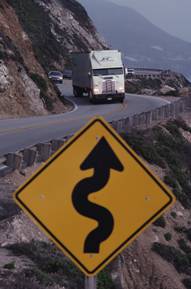U.S. Department of Transportation
Federal Highway Administration
1200 New Jersey Avenue, SE
Washington, DC 20590
202-366-4000
The FHWA Safety Program urges State and local roadway officials to consider implementation of nine safety countermeasures that show great potential to reduce highway fatalities and injuries. As State highway agencies develop plans to address the safety challenges identified in their strategic highway safety plans, they are urged to consider the benefits of investments in these proven roadway safety tools and techniques.

Road Safety Audits – A road safety audit (RSA) is a formal safety performance examination of an existing or future road or intersection. Audit teams are independent and multidisciplinary. The team reports on potential road safety issues and identifies opportunities to improve safety for all road users.
Rumble Strips and Rumble Stripes – Rumble strips are raised or grooved patterns on the roadway that provide both an audible warning (rumbling sound) and a physical vibration to alert drivers that they are leaving the driving lane. They may be installed on the roadway shoulder or on the centerline of undivided highways. Rumble stripes are rumble strips that are placed at the centerline or edgeline.
Median Barriers –Median barriers are longitudinal barriers used to separate opposing traffic on a divided highway. They are designed to redirect vehicles striking either side of the barrier. Median barriers can significantly reduce the number of cross-median crashes and the overall severity of median-related crashes.
Safety Edge –The Safety Edge asphalt paving technique minimizes vertical drop-off safety hazards. A Safety Edge shape is created by fitting resurfacing equipment with a device that extrudes and compacts the shape of the pavement edge at a specific angle as the paver passes. This mitigates shoulder pavement edge drop-offs immediately during the construction process and over the life of the pavement. Because the technique involves only a slight modification of paving equipment, it has a minimal impact on project cost. Improved compaction of the pavement near the edge is an additional benefit of the Safety Edge.
Roundabouts –A roundabout is a circular intersection where entering traffic yields to vehicles on the circulatory roadway. Roundabouts are designed to channel traffic at the entrance and provide collision deflection around a center island. Modern roundabouts are geometrically designed to reduce speeds and deflect collision forces, which substantially improves safety, while providing excellent operational performance at the intersection.
Left- and Right-Turn Lane at Stop-Controlled Intersections – Left-turn lanes are auxiliary lanes for storage or speed change of left-turning vehicles. Left-turnlanes reduce the likelihood of intersection crashes. They also make turning easier for drivers and improve the intersection’s operational efficiency. Right-turn lanes provide a separation at intersection approaches between right-turning traffic and adjacent through-traffic. This reduces conflicts and improves intersection safety.
Yellow Change Intervals – Yellow signal lights that are not timed appropriately are a safety hazard. Yellow change intervals that are not consistent with normal operating speeds create a “dilemma zone” in which drivers can neither stop safely, nor reach the intersectionbefore the signal turns red.
Medians and Pedestrian Refuge Areas in Urban and Suburban Areas – Medians reduce traffic conflicts and increase safety by providing a buffer area between opposing lanes of traffic. Medians can be open (pavement markings only), or channelized (raised medians or islands) to separate various road users. Pedestrian Refuge Areas—also known as crossing islands, center islands, refuge islands, pedestrian islands, or median slow points—are raised islands placed in the street to separate crossing pedestrians from vehicles.
Walkways – Appropriately designed walkways increase safety for all road users. Types of walkways include:
Pedestrian Walkway (Walkway) – A continuous way designated for pedestrians and separated from motor vehicle traffic by a space or barrier.
Shared Use Path – A bikeway or pedestrian walkway physically separated from motor vehicle traffic by an open space or barrier, either within a highway right-of-way, or within an independent right-of-way. Shared use paths may also be used by pedestrians, skaters, wheelchair users, joggers, and other non-motorized users. Shared use paths also are referred to as “trails” or “multiple-use trails.”
Sidewalks – Walkways that are paved and separated from the street, generally by curb and gutter.
Roadway Shoulder – In rural or suburban areas where sidewalks and pathways are not feasible, gravel or paved highway shoulders provide a safer area for pedestrians to walk next to the roadway.
For More Information
For more information on these countermeasures, visit http://safety.fhwa.dot.gov or contact:
Office of Safety
Safety.FHWA@dot.gov
202-366-2288
